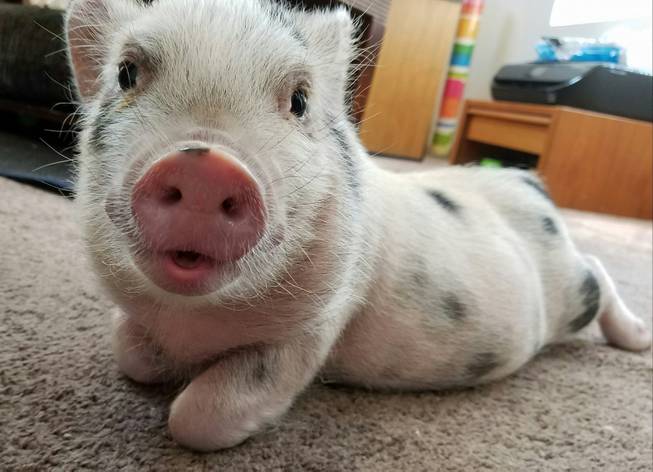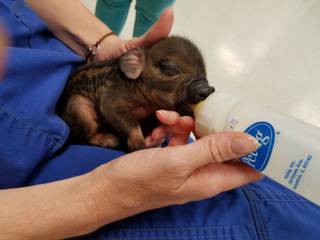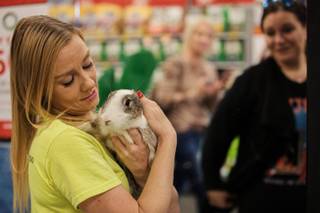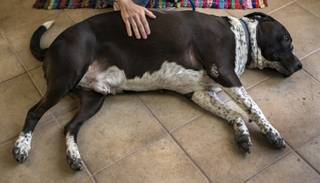
Courtesy Photo / Crystal Kim-Han
Vegas Pet Pigs is a local non-profit organization that educates potbelly pig owners. They provide sanctuary and find homes for abandoned pigs as well. Crystal Kim-Han who runs Vegas Pet Pigs posts daily photos like this one of the rescue pigs.
Sunday, Nov. 26, 2017 | 2 a.m.
Cats, dogs, bunnies, iguanas and potbelly pigs are just a few of the kinds of animals that fill up Las Vegas’ streets and shelters. Henderson’s city shelter and the Animal Foundation (the contracted shelter for Las Vegas, North Las Vegas and unincorporated Clark County) do what they can to address the needs of the thousands of pets that enter their system each year, but there’s always more pets in need than they can help.. That’s where everyday people step up and care for the forgotten pets of Southern Nevada. The small, passionate groups’ founders often use personal resources to save one animal at a time. How can you find them? Or better yet, how can you help them? We’ve rounded up just a few of the many who work on this smaller scale, striving to educate the public about adoptions and save lives. So if you’re searching for a companion, consider them. And if you’re searching for a way to help rescues efforts of all sizes, we have suggestions.
• • •
VegasPigPets
• Founded in: 2008
• Focused on: Potbellied pigs
• Details: One-woman nonprofit housing and caring for up to six rescued potbellied pigs in a permitted home sanctuary; working to adopt them out; and offering educational and behavioral support to other local pig owners.
What is the VegasPigPets adoption process like?
• Adoption fees: $100- $250
• Items included: Outdoor shelter, blankets, bag of food, popcorn/popper and bowls
• Requirements: Home check and pre-setup prior to the pig’s arrival
• Kim-Han trains her pigs before dropping them off at their forever home, where she stays until both family and pig are acclimated to their lifestyle change.
Did you know?
The average life span is 15 years, but pigs can live to be 20 years, Kim-Han said.
Two years ago, Wanda Moore drove a tiny potbellied pig from Kentucky to Las Vegas in the back of her Kia.
Now, 3-year-old Abbie weighs 200 pounds, so loading her up for her annual hoof trimming is too difficult to maneuver.
Enter Las Vegas’ one-woman pig rescue Crystal Kim-Han and her “pig flipper” Adam Beach.
Kim-Han and Beach corner Abbie, flip her on her back and begin filing her hooves. Within an hour, her hooves are neatly trimmed.
This isn’t a scene Kim-Han ever pictured. But everything changed after Pork Chop.
She purchased the piglet from another state in 2005 and bonded with other pig enthusiasts after taking Pork Chop to a trainer in Reno. Over time, she learned that the animals were frequently abandoned because owners often assumed they’d be ‘just like dogs.’
So in 2008 she founded her nonprofit, VegasPigPets, to help rehome and adopt out unwanted pigs.
“How one little piglet named Pork Chop started a whole organization still amazes me, but every day I look at my not-so-little girl and thank her for opening up a new world of wonderful people and resources,” Kim-Han wrote on her website.
She lost Pork Chop to cancer in 2012, but she continues to train and tend to other people’s pigs to relieve some pressure and encourage them to keep their hooved companions. She spends her weekends running VegasPigPets’ sanctuary and social media feeds, coordinating adoptions and combating ignorance spread by backyard breeders. On weekdays, she wakes up at 4:30 a.m. to feed the six rescues she’s caring for before heading to her full-time job.
Kim-Han hopes that through education, people will stop buying from breeders and be prepared for the challenge and reward of a pet pig.
“I keep telling people, posting about it on social media, doing press releases, but people only hear what they want to hear. They think if they’re paying that much money for a teacup pig, that guarantees it’ll be one.”
Although there are many breeds of pig, there’s no such thing as a “teacup pig,” Kim-Han warns.
“When (the piglet) keeps growing, (people) don’t know what to do but give it up,” she said. “You’re all in or you have to be all out, there’s no halfway with these guys.”
• • •
Bunnies Matter in Vegas Too
• Founded in: 2013
• Focused on: Rabbits
• Details: Organization (with pending nonprofit status) of numerous “bunny heroes” providing food and water, medical care, financial assistance and foster homes for abandoned rabbits and their offspring living in local dump sites. They also work to educate people, businesses, and they advocate for a requirement that all pet bunnies be spayed or neutered.
Meet the bunnies
• When: Every Saturday, 10 a.m. to 3 p.m.
• Where: PetSmart, 9775 W. Charleston Blvd.
Did you know?
Rabbits can reproduce every 30 days and have up to 14 babies at a time.
Two children dug graves for their pet bunnies, burying them alive near an apartment complex near Sunrise Hospital, much to the shock of a concerned neighbor looking on.
Stacey Taylor, founder of Bunnies Matter in Vegas Too, stepped in and saved the bunny pair, nurturing Ying and Yang back to health.
Taylor’s life and finances have been consumed by saving rabbits whose owners were not prepared for the reality of having such a pet. She’s up against a classic, vicious cycle: Every Easter, parents buy baby bunnies for their children. When those babies grow and require more attention, many people decide they’re not up for the cost or time commitment. Some drop the rabbits at a shelter, while others dump them at local parks or out the back door.
Pet stores aren’t required to spay/neuter them, so when they’re abandoned, they reproduce rapidly, causing the population of feral bunnies to explode in the Las Vegas Valley. Taylor estimates between 800 and 1,000 live at the most populous dumpsite outside a state-run mental health facility near Summerlin.
Even when Bunnies Matter spays or neuters a rabbit, volunteers can’t release them back into the park because that constitutes animal abandonment. So they work to keep the animals as healthy as possible until a solution can be found. That involves regularly feeding hundreds of rabbits and trying to find homes for as many as they can.
One of the most striking problems is injured rabbits at dumpsites, as many have no idea how to live in the wild. Some have broken legs or unexplained paralysis, infected eyes or flesh wounds from being hunted illegally with hawks. Others are starving because more aggressive animals drive them away from food.
Local vets reduce their rates for Bunnies Matter, but the costs pile up. One such vet opened a sanctuary to help house rabbits too traumatized to be adopted, but she asked to remain anonymous to deter people from abandoning rabbits at her office.
“Just because there’s a sanctuary,” Taylor said, “that doesn’t mean the problem will be solved.”
Taylor and her partner in Bunnies Matter, Dave Schweiger, have reached out to municipal and state authorities without much luck, so they are collaborating with other rescues, even on a national level, to find a way to make a real dent in the issue.
Pleas to officials have been stepped up as well. The organization recently submitted a proposal to the state to help cover the cost of spaying and neutering feral rabbits — the per-bunny average is $178, and Bunnies Matter is asking for $50-$60 in state support depending on the case.
Taylor and Schweiger also met with Las Vegas City Councilwoman Michele Fiore, hoping to convince her to help expand an ordinance banning the sale of dogs, cats and potbellied pigs to include bunnies, though the measure at large was just overturned.
“They keep saying they haven’t heard of the problem, but we’re making that difficult to believe by doing all these news stories, sending all these emails, showing up to meetings,” Taylor said of local leadership. “I have to believe that one day someone with the funds or land will see my work and want to help. My goal is to save as many as I can and place them into good homes, and keep the ones I can’t save as healthy as possible in the hopes of saving them all.”
• • •
• Founded in: 2009
• Focused on: Dogs
• Details: Nonprofit organization providing medical and foster care while seeking permanent homes for abandoned dogs. More than 2,000 have been rescued, and since 2012 more than $500,000 has been raised for medical treatment of those that would have otherwise been euthanized.
Desirea Auten is ready at 8 o’clock on the dot. Syringe full of insulin in one hand, leash in the other. She walks Blue out the front door on his morning walk. Actually, it might be more accurate to say the old border collie mix is walking Auten. He is pulling — they are working on that — to get to a bush quickly. He knows the drill. Once he relieves himself, he’s going to get a tasty treat.
On paper, Blue belongs to Charles Sweat. He and his wife, Patricia Ahner, both in their 80s, adopted Blue about a year and a half ago from the local rescue organization A Home 4 Spot. Since then, Ahner and the dog have both encountered medical issues. Ahner is now living with a relative who can provide live-in care, and Blue needs twice daily shots of insulin for his diabetes, as well as special food and regular vet visits.
“I just couldn’t do it,” Sweat says.
When volunteers with A Home 4 Spot heard that Blue was having issues and his new owners were struggling, they came up with a plan. Auten and others visit Blue twice a day (8 a.m. and 8 p.m.) to administer the medicine and take him on a long walk. They are trying to raise money for an eye surgery Blue needs to correct vision loss that happened as a result of the diabetes.
“It would be easier to take him back,” Auten says. “I could give him his shots at my house, but that’s not the point.”
Blue and Sweat have bonded. Every morning, when the latter wakes up, the former is waiting at the end of his bed. He rests his head on the mattress to get some head pats. Sweat spends most of his day watching television with Blue at his feet. When he gets up to use the restroom, Blue follows.
Keeping the pair together keeps them both happier and healthier, Auten says.
Sweat agrees. “I don’t know what I’d do without them,” he says, referring to the volunteers who rotate through 14 home visits each week. “They are angels.”
While animal rescues get the most attention for the intake and adoption of animals, pet retention and assistance often is a large component of the work they do. On a case-by-case basis, A Home 4 Spot assists struggling owners who might otherwise have to euthanize or surrender their pets to a shelter.
Like many nonprofit rescues, A Home 4 Spot requires the people who adopt dogs from it to return the animal if their circumstances change and they can no longer care for it. Auten says they like to view all of the dogs who’ve been through their nonprofit as being part of an extended family.
“You can’t just forget about the animal once it’s out the door,” she says. “There’s so much that goes into it.”
• • •
Other grassroots rescues
It’s impossible to gauge how many people are working for animal welfare across the Las Vegas Valley. Whether it’s one person or a legion of volunteers, their work helps pets get healthy and find forever homes. We snapshotted just a few of the many in action.
• Foreclosed Upon Pets: Dogs and cats that have been abused and/or abandoned as a result of economic hardship (from foreclosure to illness) are scooped up by this nonprofit. It hosts adoption events and provides a lost-and-found portal for pet owners and finders.
• Southwest Exotic Avian Rescue: Pet birds are the focus for this all-volunteer nonprofit. It supports people in keeping their birds or works to rehome them. They are evaluated for general and nutritional health, and behavioral problems that might be barriers to adoption are addressed.
• Connor and Millie’s Dog Rescue: CMDR is named for and devoted to senior rescues, giving foster parents tutorials, emergency support and money for medical needs. Last year, the nonprofit took in 111 animals (most from shelters, with a few strays/surrenders) and adopted out 46.
• Reptile Rescue From iguanas and box turtles to snakes, this animal-loving couple will find help for any reptile dropped into their care. They rely on social media to spread the word about adoption opportunities and help needed by reptiles in other communities.
• Happy Home Animal Sanctuary: This no-kill, no-cage, all-volunteer nonprofit offers open-space living for homeless, elderly or abused cats and dogs and works to adopt them out through its website and events at PetSmart. Those who can’t find homes are given a lifetime refuge.
• Wagging Tails Rescue: Volunteers target animals in danger of being euthanized at shelters, giving them loving temporary homes until they can be matched with new owners. The nonprofit hosts Petco adoptions on weekends and is always looking to develop foster parents.
• More rescuse: Visit Las Vegas Pet Scene Magazine’s database.
• • •
How you can help
Becoming a one-person animal-rescue machine and launching your own nonprofit organization isn’t an option for everyone, but there is no shortage of ways for animal lovers to get involved. Whatever your capacity or resources may be, rescues say there is a way you can contribute to their mission.
• Share: Most independent rescue organizations spend their money on their animals, not advertising. That means they rely solely on word of mouth to get the news out about available pets, upcoming events and information. Social media, especially Facebook and Instagram, is the platform of choice for most rescues. Following along and sharing their posts with your own network of friends and acquaintances is an easy way to stay engaged. And the best part is, it’s something you can easily fit in between sharing photos of your brunch and babies.
• Educate yourself (and others): Too often, animals wind up on the streets or in shelters because their owners failed to do the proper research before purchasing them. Desirea Auten with A Home for Spot says she lost count of the number of times people have reached out saying they want to surrender their terriers because they are too high-energy. “That’s what a terrier is,” she says. Similarly, Crystal Kim-Han of VegasPigPets says too many people are fooled by unscrupulous breeders who promise that so-called teacup pigs will stay tiny and cute forever, when really they will quintuple in size. Educating yourself — and respectfully enlightening those around you — is an easy way to promote responsible ownership and help keep animals from ever ending up at a shelter or rescue.
• Donate money or goods: Rescues and shelters are in constant need of more financial resources and goods. Money is always a good option because it allows them to utilize it wherever their greatest need is, but pet supplies are typically also appreciated. If your furry friend outgrows her collar, kennel or carrier, consider donating the used one to an organization instead of throwing it out or letting it collect dust in the closet. Many shelters also accept (clean) linens, which they use as bedding. Do a bit of research to pinpoint their needs.
• Volunteer your time: Finding people to donate time and skills to a rescue is key to success because it saves them money and prevents burnout of key personnel. Most people intuitively know volunteers are needed, but many don’t realize the full range of volunteering options. It’s not all playing with puppies at public adoption events. A lot goes on behind the scenes, and rescues need people with professional or technical skills — a webmaster to build or maintain a website, a photographer to take photos of animals, an event organizer to help build fundraising opportunities, an accountant to help with taxes or bookkeeping. Even a “pig flipper” to help with nail trimming.
• Foster: Independent rescues typically don’t have their own shelters where they can house animals. Instead, they rely on people who open up their homes to animals until permanent (“furever”) homes can be found. Most rescues provide resources and absorb some of the costs of fostering. Because animals come with a variety of needs and backgrounds, various foster situations are needed. Some animals are better off in homes where no other animals live. Others are better with families with children or other companion animals to keep them stimulated. Many people worry about not being able to say goodbye to a foster pet once a permanent home has been found, and while that can be emotional, most say the joy of knowing you helped outweighs any other emotion.



